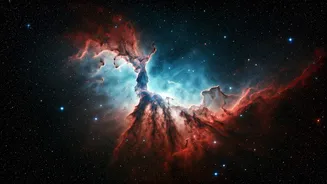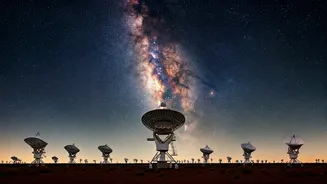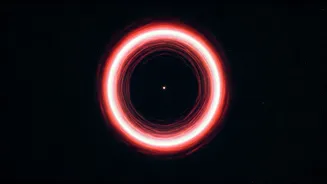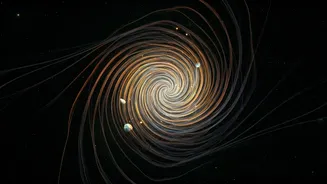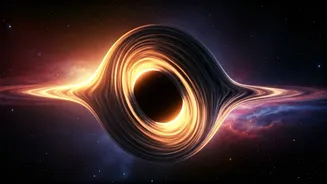What is Dark Matter?
Dark matter is a hypothetical form of matter thought to account for approximately 85% of the total matter in the universe. Unlike ordinary matter, which
interacts with light and can be observed directly, dark matter does not emit, absorb, or reflect light. Its existence is inferred from its gravitational effects on visible matter, such as galaxies and galaxy clusters. For instance, the observed rotation speeds of galaxies cannot be explained by the visible matter alone; the presence of dark matter provides the extra gravitational force needed to hold these galaxies together. Other evidence includes gravitational lensing, where the light from distant objects is bent by the gravity of massive objects like dark matter, and the cosmic microwave background, which shows subtle variations consistent with the presence of dark matter in the early universe. Scientists use sophisticated instruments and calculations to estimate the distribution and properties of dark matter, constantly refining our understanding of its role in the cosmos.
Searching for Proof
Detecting dark matter directly is one of the most significant challenges in modern physics. Scientists employ various methods, including the use of underground detectors to shield from cosmic rays and other background noise. One major approach is the search for Weakly Interacting Massive Particles (WIMPs), a leading candidate for dark matter. These detectors are designed to identify the rare interactions between WIMPs and ordinary matter. Another method includes axion searches, which use powerful magnets to convert axions into detectable photons. Moreover, indirect detection methods look for signs of dark matter annihilation or decay, such as excess gamma rays or neutrinos, that might be produced by these interactions. Experiments like the Large Underground Xenon (LUX) and XENONnT detectors, deep underground, are actively searching for direct interactions. Each experiment provides crucial data, pushing researchers closer to understanding the nature of dark matter.
Current Research Efforts
Numerous research projects are dedicated to understanding dark matter. Particle physicists build and operate massive colliders to recreate the conditions of the early universe. These facilities help them study the behavior of known particles and search for new ones that might be linked to dark matter. Cosmologists study the cosmic microwave background radiation to learn about the early universe's conditions and trace dark matter's effects on the structure of the cosmos. Astrophysicists utilize telescopes and advanced simulations to study galaxy formation and evolution, trying to understand how dark matter influences the clustering of galaxies. Data from space-based observatories such as the James Webb Space Telescope and the Fermi Gamma-ray Space Telescope is vital for studying the distribution of dark matter across the universe and looking for signals of its interactions. All these varied approaches work in concert to unravel the mystery of dark matter.
Challenges and Hurdles
The search for dark matter presents significant challenges. The weak interaction of dark matter with ordinary matter makes direct detection exceedingly difficult. Background noise from cosmic rays and other sources further complicates the task, requiring highly sensitive detectors and sophisticated shielding techniques. The theoretical nature of dark matter, with several potential candidates (WIMPs, axions, and other possibilities), necessitates extensive experimentation and analysis to narrow down the possibilities. Moreover, the lack of definitive detection so far raises questions about the models used and the nature of dark matter itself. Data from one experiment might not always corroborate with results from another. Overcoming these hurdles demands advanced technology, innovative experimental designs, and international collaborations among scientists across multiple disciplines.
Future Discoveries Possible
The future of dark matter research promises exciting possibilities. Continued advancements in detector technology, such as the development of more sensitive and larger detectors, should increase the chances of direct detection. Improved particle accelerator experiments could provide new insights into the properties of dark matter candidates. Increased computational power and more sophisticated simulations will enhance our ability to model and interpret the complex effects of dark matter on the universe. Furthermore, cross-disciplinary collaborations, bringing together particle physicists, cosmologists, and astrophysicists, may lead to breakthroughs in understanding the fundamental nature of dark matter. Discovering dark matter would revolutionize our understanding of the universe, providing vital clues about its composition, formation, and evolution.
